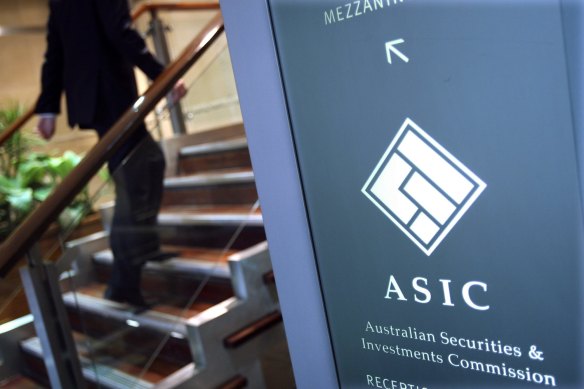Opinion
More dog than watchdog: How to fix our broken corporate regulator
Elizabeth Knight
Business columnistReading Wednesday’s Senate inquiry report on our corporate regulator, the Australian Securities and Investments Commission, its flaws, indolence, ineffectiveness and state of cultural disease suggest it’s a dog rather than a watchdog.
In short, the report concludes it is a regulator that has failed in its sole mandate to enforce the country’s corporate laws and is in a “dire” state with an unenviable prosecutorial rate.

Liberal senator Andrew Bragg says ASIC has failed.Credit: Alex Ellinghausen
This explains why the Senate committee chaired by Liberal Andrew Bragg has recommended the nuclear approach to fixing it – by breaking it into two.
Bragg has taken a big swing in pushing for the regulator to give birth to two separate entities, one that will police companies and the other that will cover financial services, given demarcation could be messy.
However, highlighting ASIC’s failings presents a rich target.
There is no shortage of superlatives in the Senate report to describe ASIC’s faults, leaving the reader to wonder whether Australia must be a magnet for white-collar crime.
“While ASIC tries to deflect criticism that it is a weak corporate regulator by promoting its recent enforcement actions, the reality remains that corporate law is under-enforced in Australia. ASIC’s response to most reports of alleged misconduct is to take no further action, and only a fraction of reports are investigated,” the report reads.
“For the matters where ASIC proceeds to take enforcement action, the civil penalties imposed are often at odds with the scale of the offending, and few criminal sanctions are achieved. Further, ASIC’s investigation and enforcement decisions are opaque and difficult to scrutinise.”
For decades, ASIC has been the subject of criticism, so an inquiry into its structure and performance provides fertile ground for any politician looking for a headline.
The regulator’s bona fides were particularly ravaged in 2018 by the royal commission into financial services, which shone the spotlight on its failures to police bank, insurance and superannuation companies involved in egregious misdeeds and breaches of law – including the memorable “fees for no service” and charging of dead customers.
There is no shortage of superlatives in the Senate report to describe ASIC’s faults, leaving a reader to wonder whether Australia must be a magnet for white-collar crime.
It was accused of having an unhealthily cosy relationship with the companies it was required to regulate, to the point it was widely labelled a captive regulator.
Thus, the consumers and investors it was mandated to protect had, in effect, become victims without appropriate recourse.
Scarred by that royal commission attack, ASIC changed its modus operandi to embark on what it called a “why not litigate” approach. This approach lasted only a few years before it morphed into a regulatory-lite “express investigation” approach that featured more co-operation than pugilism.
Ongoing criticism of ASIC has arguably spawned the siege mentality it often displays – one that may be accountable for what the Senate report describes as a lack of transparency and cultural issues.

ASIC faces the prospect of being split into two entities.Credit: Jim Rice
To be fair, the degree of success of any regulator is often the product of its funding relative to the size of its remit. And while ASIC has received some additional finance over recent years, it has an enormous job with arguably insufficient resources.
ASIC’s remit spans companies, markets, financial services, consumer credit and professionals who deal with financial products.
In 2021–22, ASIC regulated more than 95,000 entities, including 1841 public companies, 6288 financial services licensees and 1183 securities dealers.
This includes Australia’s $4.75 trillion of pooled management funds and $3.9 trillion of retirement savings.
But it performed its job with less than 2000 staff and an $861 million budget.
Other than the Senate committee’s push to split ASIC into two agencies, its other suggestions are both thoughtful and reasonable.
It should legislate that ASIC, or its successor, lifts the rate of investigating alleged misconduct and becomes far more transparent.
It also suggests the government should consider improving laws protecting whistleblowers by offering financial incentives or compensation to those “that are unable to make a disclosure in the public benefit without experiencing significant personal detriment, such as the loss of career prospects”.
Finally, it asks the government to examine the funding model, effectively allowing the regulator a bigger slice of the fee and fine revenue it generates.
This would be hard to argue against.
The Business Briefing newsletter delivers major stories, exclusive coverage and expert opinion. Sign up to get it every weekday morning.
correction
An earlier version of this story incorrectly stated that Australia had $4.75 billion of pooled management funds and $3.9 billion of retirement savings when it should have said trillions.